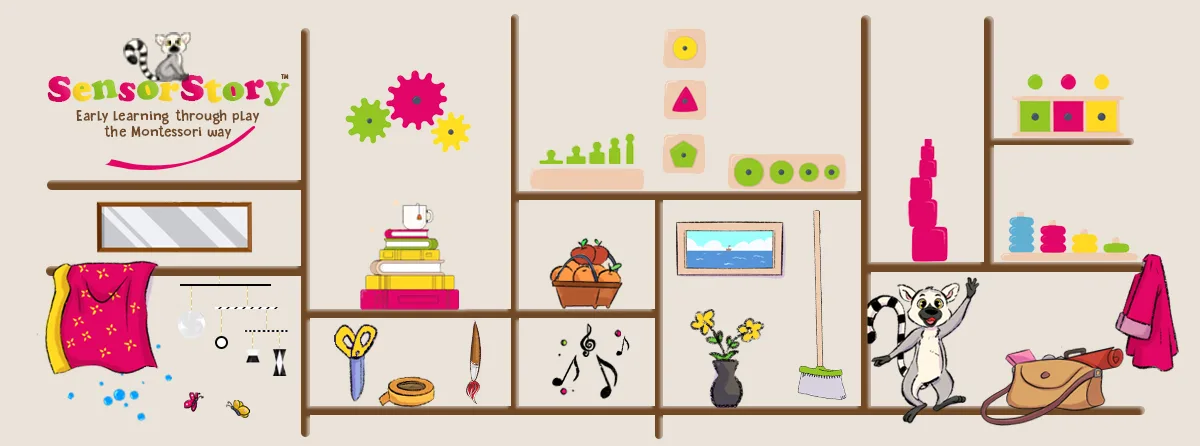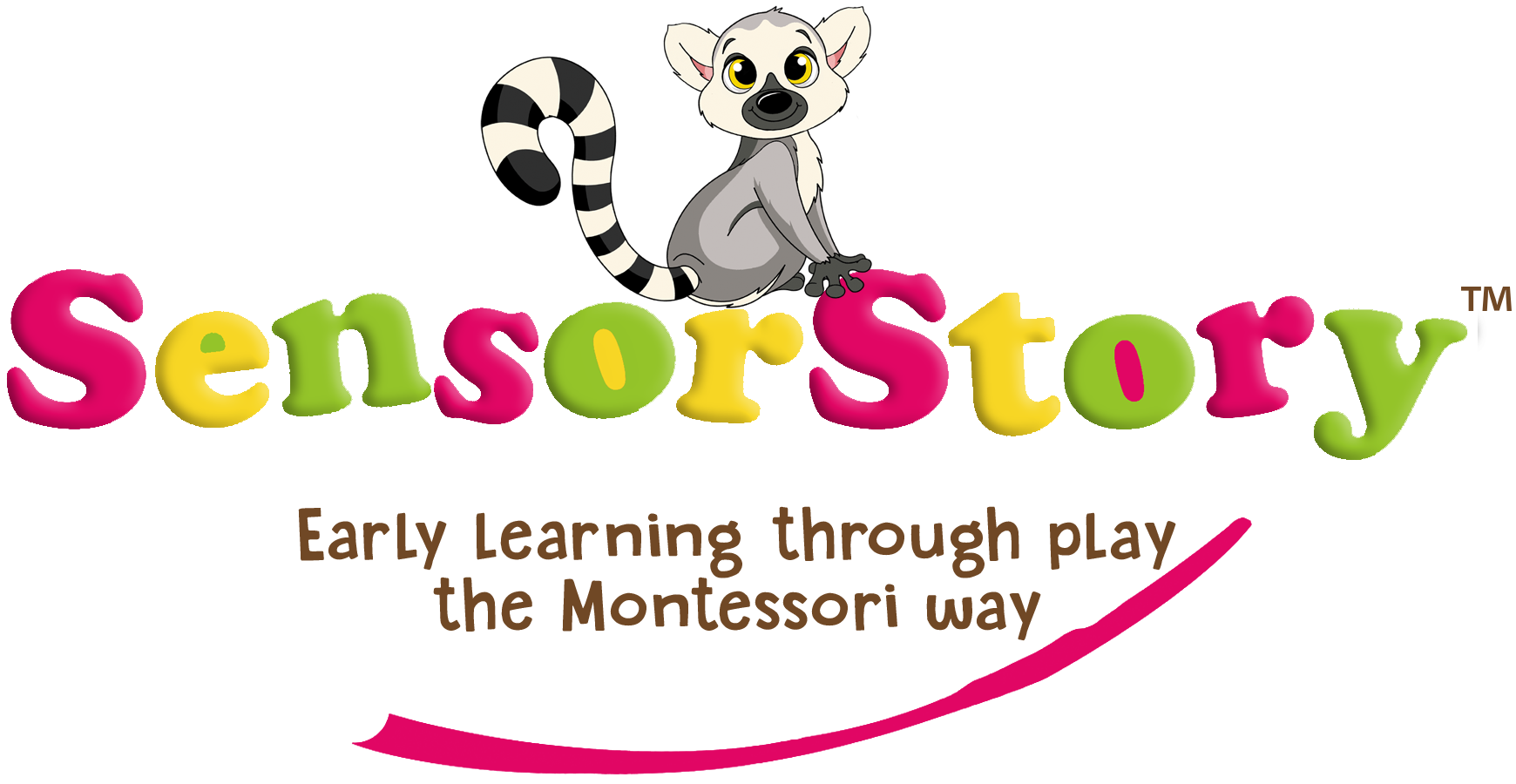We've put together a detailed list of at-home Montessori-aligned activities suitable for a 12-month-old.
Here you will see age-appropriate activities for all areas, in our Ultimate Series Of Activities to try at home, where the emphasis is on providing a prepared environment and allowing the child to actively engage in self-directed learning.
So what is my child working on mastering at this age?
Between the 12-14 month age, typically you will see your baby focused on mastering motor skills like walking, refining language development, fostering independence in self-care activities, exploring the environment independently, and experiencing ordered and organised spaces to enhance their sense of security.

1. Practical Life Skills:
* Introduce simple self-care routines, such as letting your baby wash hands or brush teeth.
* Provide a small, child-sized broom or mop for them to participate in cleaning activities.
* Encourage baby to drink from a child-sized cup independently.
* For further guidance on Practical Life Skills and activities by age, click here.
2. Fine Motor Skills:
* Offer baby a small spoon and a bowl of dry beans or rice, pom-poms or cotton balls, and show them how to scoop the items from the bowl into another container.
.
* Introduce baby to simple puzzles, such as knob puzzles, shape sorters, or peg puzzles.
* Cubes on a vertical dowel: offer your baby a toy with a vertical dowel and some wooden cubes for them to stack and unstack them on the dowel.
* Provide baby with child-safe scissors and show them how to hold and cut along the lines of paper strips.
* Wet pouring: offer baby a small pitcher and a cup and show them how to pour water from the pitcher into the cup.
* Threading: have large wooden beads and a string and show them how to place the beads onto the string.
* Stacking blocks: Offer baby large blocks and show them how to stack them, helping to develop hand-eye coordination and spatial awareness.
3. Movement:
* Set up a safe space for crawling, climbing, and exploring gross motor movements.
* Provide your baby with a safe and sturdy climbing structure like foam steps, a Pikler triangle, or a climbing mat.
* Create an obstacle course using pillows, cushions, tunnels, and other safe objects from around the house to encourage crawling and movement.
* Offer a ball pit and encourage your baby to play with balls to help develop hand-eye coordination and gross motor skills.
* Provide your baby with a steady and sturdy walker wagon to support them as they take their first steps.
4. Sensory Exploration:
* Create a sensory bin with safe materials like rice, beans, or soft fabric for tactile exploration.
* Offer various textures for your baby to touch, such as smooth stones, soft fabric, and rough sandpaper.
* Encourage baby to explore different scents by providing them with a variety of smelling materials like flowers, herbs, or spices. You can also create a scent basket filled with different smelling objects like lavender sachets, cinnamon sticks, or citrus peels.
* Create a light box filled with different coloured objects.
* Explore sensory play with home-made playdough.
* Messy play: offer messy play opportunities with materials like finger paint, pudding, or mud. Explore textures and sensations through hands-on activities, using descriptive words for the sensations experienced. Click to read more on the benefits of Messy Sensory Play, and for a homemade finger paint recipe.
5. Language Development:
* Offer baby a variety of books, such as board books, cloth books, or books with real photographs. You can read the books to your baby and point out the different words and pictures, helping to develop language, literacy, and visual skills.
* Engage in conversations with the child, responding to their attempts at communication.
* Talk to your baby throughout the day and describe what you are doing. Use simple words and short sentences.
* Engage in Baby Sign Language with your baby. Teach your baby simple signs like “more,” “all done,” and “milk” to help them communicate before they can speak. To learn more about using Baby Sign Langauge click here.
6. Sorting and Categorising:
* Provide objects for baby to sort by colour, shape, or size.
* Offer simple sorting activities with everyday items like clothes or household objects.
* Introduce a shape sorter or stacking rings for categorisation.
7. Outdoor Exploration:
* Arrange outdoor play sessions to explore natural elements like grass, sand, or leaves.
* Provide a safe outdoor space for the child to practice walking or running.
* Introduce simple gardening activities with safe, child-friendly plants.
* Bug hunt: Go on a bug hunt with your baby and let them observe different insects like ants, beetles, and butterflies. You can also provide them with a magnifying glass to get a closer look.
* Use natural materials like leaves, flowers, and twigs to create art.
8. Art Exploration:
* Offer child-friendly art materials such as large crayons, washable paints, or playdough.
* Encourage creative expression through simple art projects like finger painting or stamping.
* Tearing and pasting: offer your baby some coloured tissue paper let them tear shapes. Provide them with glue and a piece of paper or card to stick the pieces onto.
* Create DIY sensory paints using safe ingredients like pudding or yogurt mixed with natural food colouring.
* Use everyday objects like sponges, cotton balls, or leaves to create different textures and patterns on paper.
9. Independence in Mealtime:
* Provide child-sized utensils and plates for self-feeding during meals.
* Encourage your baby to participate in food preparation activities, such as stirring or pouring.
* Introduce a small table and chair set for independent eating.
10. Social Interaction:
* Model and encourage taking turns during play with simple turn-taking activities such as passing a soft ball back and forth. Learn more about why Montessori advocates Turn Taking Over Sharing here.
* Arrange playdates with other children, helping to develop social skills, empathy, and emotional regulation by learning to take turns, and communicate with others.
* Engage in responsive communication, mirroring baby's sounds and expressions.
* Play peek-a-boo with your baby using a blanket or a scarf. This activity helps baby develop object permanence and social skills by learning to anticipate your return.
* Read books with your baby and encourage them to turn the pages.
11. The Whole Child Development:
* Attend our weekly SensorStory Baby and Toddler Montessori parent-child sensory classes! Follow this link to enrol your infant here.
We hope we have given you some inpiration for activities to do with your 12-month-old!
Remember, follow the child, adapting activities based on your observation of your baby's developmental stage and individual interests. The key in a Montessori environment is to provide your child with real, purposeful, and age-appropriate tools and materials that allow them to engage in activities independently and at their own pace.
Disclaimer: Adult supervision is required for any activity suggested by SensorStory. Please follow any directions and/or warnings on the labels(s) of any materials used during such activity & be aware of any potential choking hazards or allergies.
Click here to see our
'Activities To Do With A 13 Month Old
FAQ.
